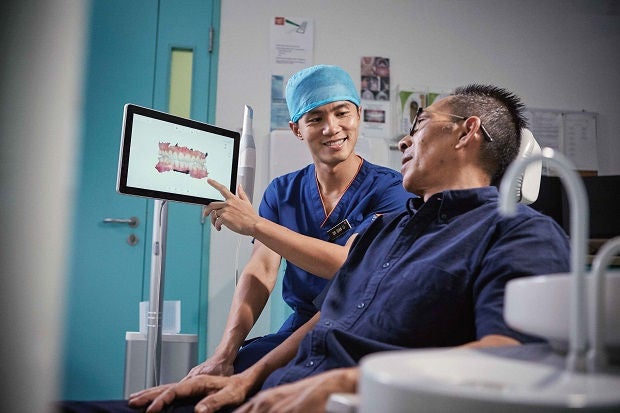
Today, he helps other patients with similar and other complex orthodontic issues.
As an orthodontist, Dr Qian has gone through specialised training in the field of dentistry to treat complex cases of crooked teeth.
His personal experience of receiving orthodontic treatment in secondary school sparked his interest in the field of dentistry.
“My case was not so severe. Although I did not need surgery, I required braces treatment with some extractions to provide adequate space to correct crowding, bite issues, and midline deviation,” he said.
“I could smile with confidence again, thanks to my orthodontist, who turned out to be my instructor during my orthodontics specialisation course many years later.”
Despite discovering other fields of dental specialisations as an undergraduate dentistry student, Dr Qian said that his interest in the art of straightening teeth led him to do a three-year Masters in Orthodontics programme in the National University of Singapore, followed by a three-year post- Masters specialist accreditation.

“The most challenging part of this journey to become an orthodontist was not the long years of training, but the early undergraduate years in dentistry. It requires you to not only master the knowledge and skills, but also to manage patient with compassion, and understand their needs and priorities in life. There is no one-size-fits-all treatment. Some patients may prioritise aesthetics, while others require treatment to correct their bite issues and improve their ability to eat,” he said.
Currently, most of Dr Qian’s patients are aged between 12 and 18, although he has also seen patients as young as seven years old. Common problems among this group are teeth eruption and bite issues, which can deteriorate without early intervention.
Older patients over the age of 60 usually wish to straighten their teeth for a more aesthetically pleasing smile or require teeth movement before they can have their dentures done.
At NDCS, orthodontists also see patients with severe asymmetry or discrepancies in their jaws, which can result in significant facial deformity and functional problems. Other cases include patients whose multiple adult teeth have failed to erupt.
For more complex cases, Dr Qian works with other dental specialists, such as prosthodontists and oral maxillofacial surgeons, to plan for jaw surgeries and to achieve the best outcome for patients.
Perfecting his art
Many people have the misconception that braces is only about straightening crooked teeth and purely for cosmetic purposes.
“There are many reasons to move teeth to a more optimal position for long-term function and maintenance, even if such movements may not be easily visible when the patient smiles. It takes years to master skills in diagnosing, planning and delivering orthodontic care with minimal risks, and possibly a lifetime to perfect that art,” he said.
Explaining why he regards orthodontics as an art, Dr Qian said, “Two orthodontists may achieve a different bite or smile for the patient, as they may have varying perceptions of what is considered a more aesthetic outcome.”
Witnessing the transformation in patients who have completed their treatment gives him tremendous satisfaction.
“Every patient case is a unique one- to two-year relationship, which plays a part in his or her growing years. It is heartwarming when patients say that they are inspired by me to pursue a career in dentistry,” Dr Qian added.
Evolving with the times
As Head of Dental Officers Advanced Practice Programme at NDCS, Dr Qian manages up to 40 junior dental officers. He stresses the need to continuously learn and adapt to the changing times to stay relevant — for instance, the rapid development of clear aligner technology, which uses threedimensional (3D) computer-aided design and 3D printing technology that can now aid clinicians in diagnosing and planning the patient care journey.
Personal interests
Outside of work, his interest in technology is evident through his hobbies. He was part of the Youth Flying Club during his junior college days, and now he spends his free time learning to fly planes in flight simulators and familiarising himself with developments in virtual reality (VR).
“VR can be a useful tool in the future when conducting training for dentistry or surgeries, but it is unlikely to replace reallife practice as tactility is still key in the field of orthodontic treatment,” he said.













 Get it on Google Play
Get it on Google Play